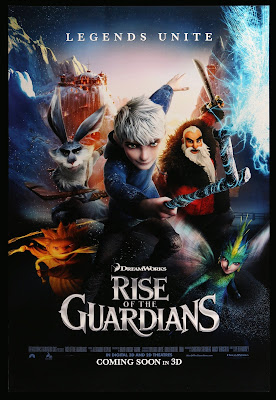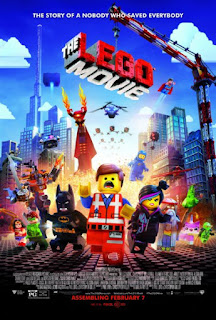Film Review: Dreamworks' "Rise of the Guardians" (2012) - Character Archetypes
 |
| Figure 1. “Rise of the Guardians” |
Dreamworks’ “Rise of the Guardians” (2012), directed by Peter Ramsey, is a whimsical telling of classic fairytales and myths in a modern style. It appears that the film is sort of an Avengers style visualisation of something that most people wouldn’t normally associate with ancient beings of folk lore and bedtime stories. With its cheerful disposition and colourful settings, it’s a classic for all of the family to enjoy. It can be noted that this film has incorporated The Hero’s Journey into its script, and so it will therefore also incorporate the theory of character archetypes. Character archetypes are personality descriptors for characters in creative media. The idea is to explore this theory within “Rise of the Guardians” (2012).
The story begins with who we can assume is our ‘Hero’ of the story, Jack Frost. It is a mystery as to where he originated from or who he is at this time, all we know is that he is floating within the icy water of a lake, and all that is clear in his view is the Moon; bright, peaceful, possibly powerful given the composition of the shot. The Moon seems to play a key part within Jack’s identity, for he even says so himself, ‘My name is Jack Frost. How do I know that? The Moon told me so. But that’s all he ever told me.’ Despite being given a name and nothing more, Jack could be considered a ‘Reluctant Hero’ due to his displeasure at being told very little on what to do with his new-found powers. It appears that throughout the film, The Man in the Moon, or Manny, as the other guardians so affectionately call him, tends to speak at particular intervals, leaving cryptic messages and vague advice for the other to figure out. Because of this, it can be noted that The Man in the Moon can be considered ‘The Herald’, the on who distributes the Call to Adventure. He could also be recognised as the ‘Threshold Guardian’ because he is responsible for bringing Jack from his ordinary old world into the world and his new roles as a mythical being and soon to be guardian.
The premise of “Rise of the Guardians” (2012) is that each guardian has a sworn duty to protect the children of the world; their powers rely on the children believing in them. But that belief is threatened when the infamous boogey man, Pitch Black, saunters around corrupting the innocent dreams of children with malicious nightmares. This results in Pitch Black being the ‘Shadow’ archetype of the film, wrecking havoc on the guardians and their designated holidays, whilst reminiscing of a time where he was at his peak, The Dark Ages. This could also be ironic as he literally works from the shadows. As well as this somewhat obvious assumption, we could also perceive Pitch Black to be the ‘Trickster’, because he is constantly playing tricks on the guardians, but he also plays with Jack’s mind and emotions, playing on the fact that Jack Frost longs for nothing more than to be seen by the children, instead of being invisible.
In a less malicious sense, Jack Frost, as well as being the ‘Hero’ of the story, could also be considered a ‘Trickster’ due to his playful mannerisms. Fun is his personality, it’s what he’s best known for. As Santa Clause queried about in the film, it is his “centre”.
As Jack is ever so reluctantly recruited to become a guardian, he will be joined by the likes of some familiar names, but perhaps not so familiar faces, as each character is styled to be the less conventional definition of their name and more modernised and far-fetched. His ‘Allies’, as well as his guardian ‘Mentors’, will be that of Santa Clause; a strong tattoo-covered Russian gentleman towering over everyone, The Easter Bunny; a 6 foot high sharp featured rabbit with a thick Australian accent, The Tooth Fairy; a zippy, fast talking, hummingbird inspired being who goes crazy for Jack’s pearly whites, and The Sandman; a silent being, somewhat overlooked, yet ever vocal without actually speaking.
Each of these characters also play an individual key role in Jack’s journey of self discovery. To start with one of the most prominent beings in the film, Santa Clause is a burly figure, somewhat intimidating, almost like he’s running a military operation rather than a toy workshop. And yet, despite his appearance, he is kind and caring, and at his ‘centre’, he is but a child full of wonder. And this is what brings Jack out of his shell, the fact that Santa plays somewhat of a ‘Father’ figure to him, guiding him on a path to discovering his core values.
Then there is The Tooth Fairy, sweet, protective, and possibly the ‘Maiden’ to the story. Although she’s not your typical damsel in distress, she does represent some of the innocence portrayed in the film.
And we have The Easter Bunny, a sharp tongued and quick witted guardian who doesn't shy away from hiding his displeasure in most things, especially Jack Frost, seeing as the mischievous chap keeps messing with Easter with his frosty powers. Being as grumpy as he is, contrasting with his fluffy demeanour, it can be assumed that The Easter Bunny can be classified as a ‘Shapeshifter’ because his true intentions aren’t exactly revealed until the end of the film.
With all of their help and advice, the guardians team together to thwart Pitch Black’s devious plans to corrupt the children of the world’s beliefs. Although the guardians rely on the belief of children, this storyline can have some criticisms. As Matt Goldberg wrote in his review, “Being invisible is the worst fate for a guardian. For all of the claims of protecting the children and bringing them joy, it’s a system based entirely on fame.” (Goldberg, M. 2012).
As children play a key part in the movie, especially relating to the guardian’s powers and existence, it’s safe to say that the children of the film represent the ‘Child’ archetype. Jamie, his little sister Sophie, and all of their friends represent that of curiosity and excitement, their innocent minds willing to believe in these mythical beings and their magical powers.
And as for the ‘Mother’ archetype within “Rise of the Guardians” (2012), the role isn’t necessarily immediately obvious. On one hand, there is Jamie and Sophie’s mum, a faceless figure who isn’t seen but is always heard in the background, a voice of reason and nurturing, with the action as simple as putting a hat on Jamie as she says “we don’t want Jack Frost nipping at your nose”. However, on the other hand, we could say that The Tooth Fairy took on a dual role, playing ‘Mother’ to all of her small hummingbird fairy workers, caring for their wellbeing and fighting for their freedom after they were captured by Pitch Black.
Overall, despite having some flaws, the fast-paced and exciting chase scenes, combined with its incredibly well animated characters and environments within “Rise of the Guardians” (2012) is an enjoyable feature and still emits a festive cheer that will lift anyone’s spirits. Like Olly Richards states, “The mark of a well-considered fantasy universe is that you can imagine it continuing even outside of the story and this feels like a world, not just a setting.” (Richards, O. 2011). One may even start believing in the guardians themselves.
The story also fits in neatly with The Hero’s Journey, and the character archetypes can be distinguished, although some roles are due to interpretation. However, does a story give us these archetypes? Or do the archetypes give us a story? It’s interesting to ponder after analysing the film. The story seems to be very driven by the mission on making the children believe in the guardians, but lacks the chance to unfold the characters stories and personalities in depth. Does that make it a bad film? Not necessarily, as it is still enjoyable to watch, but there is always that potential to explore things more.
Bibliography
Goldberg, M. (2012) “Rise of the Guardians Review” In: https://collider.com [Online] At: https://collider.com/rise-of-the-guardians-review/ (Accessed on 27.10.19)
Richards, O. (2011) “Rise of the Guardians Review” In: https://www.empireonline.com [Online] At: https://www.empireonline.com/movies/reviews/rise-guardians-review/ (Accessed on 27.10.19)
Illustrations
Figure 1. “Rise of the Guardians” (2012) [Movie Poster] At: https://www.originalfilmart.com/products/rise-of-the-guardians-2012 (Accessed on 27.10.19)
Figure 2. “Jack Frost creating mischief” (2012) [Movie Still]
Figure 3. “Pitch Black and Sandman” (2012) [Movie Still]
Figure 4. “The Guardians in battle” (2012) [Movie Still]
Figure 5. “The Children watching in wonder” (2012) [Movie Still]
All At: https://animationscreencaps.com/rise-of-the-guardians-2012/ (Accessed on 27.10.19)
Figure 3. “Pitch Black and Sandman” (2012) [Movie Still]
Figure 4. “The Guardians in battle” (2012) [Movie Still]
Figure 5. “The Children watching in wonder” (2012) [Movie Still]
All At: https://animationscreencaps.com/rise-of-the-guardians-2012/ (Accessed on 27.10.19)







Comments
Post a Comment